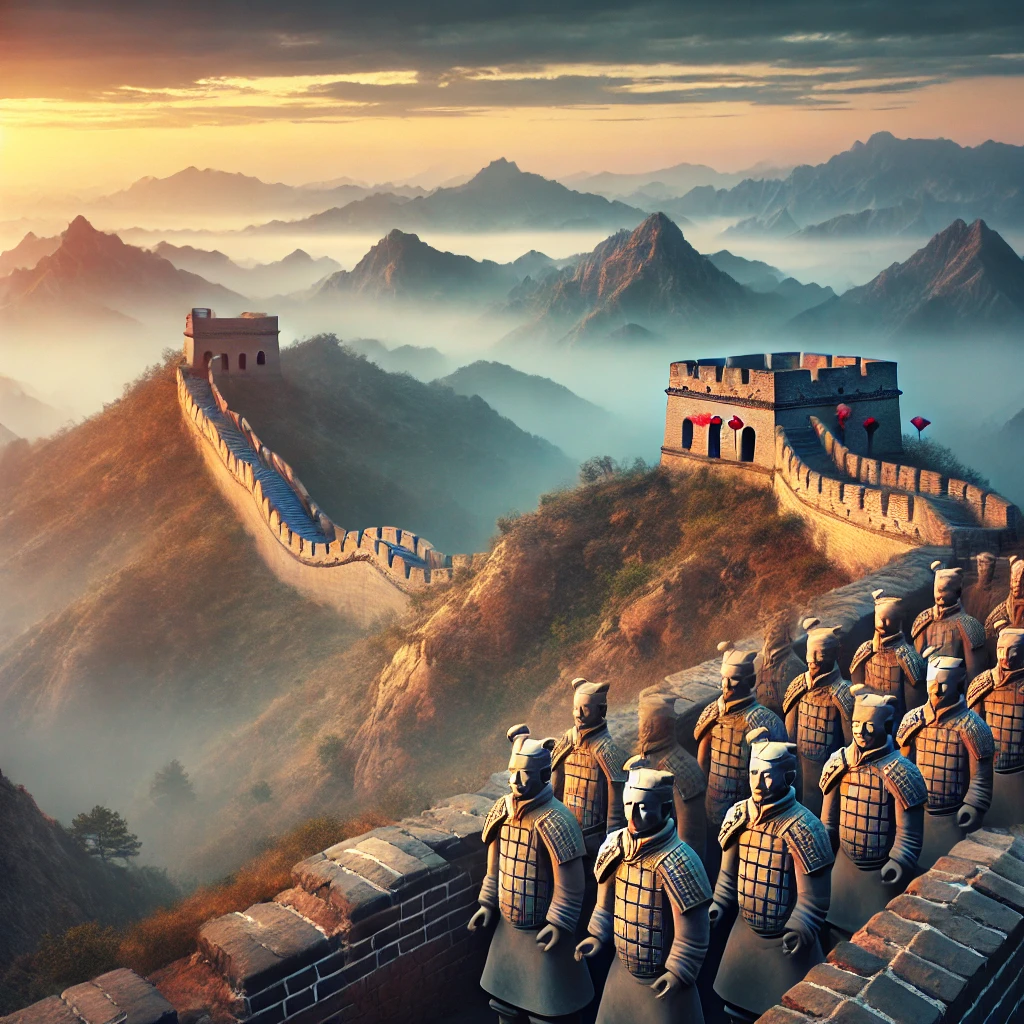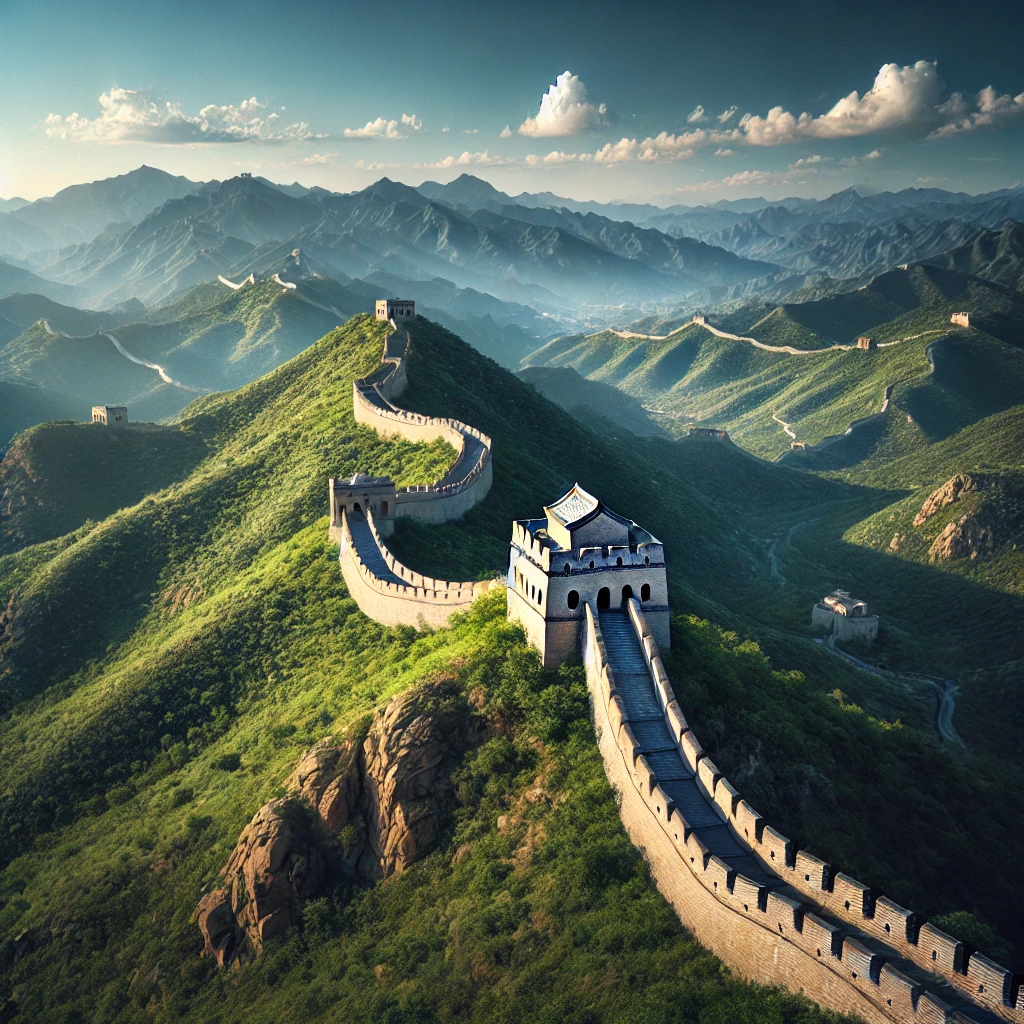Table of Contents
Introduction to China’s Ancient Wonders
China, a country steeped in history and cultural significance, is home to a plethora of ancient wonders that showcase its rich heritage. These remarkable sites not only reflect the architectural prowess and artistic expression of bygone eras, but also serve as testaments to the enduring legacy of Chinese civilization. From the majestic Great Wall to the enigmatic Terracotta Warriors, these landmarks encapsulate the essence of China’s historical journey and provide a glimpse into the lives of those who came before.
The Great Wall of China stands as one of the most iconic symbols of the nation, drawing millions of visitors each year who seek to walk along its ancient stones and fathom the immense labor that went into its construction. Spanning over 13,000 miles, the wall was built during different dynasties to protect against invasions and to secure trade routes. Its significance transcends mere militaristic utility; it represents the unity and determination of the Chinese people in safeguarding their land.
Equally impressive are the Terracotta Warriors, a collection of life-sized sculptures buried with China’s first Emperor, Qin Shi Huang. Discovered in 1974, this archaeological marvel depicts an entire army tasked with protecting the emperor in the afterlife. Each figure is uniquely crafted, showcasing the artistry and craftsmanship of ancient Chinese artisans. The Terracotta Warriors offer valuable insights into the period’s military practices, armor, and social hierarchy, highlighting the remarkable achievements of the Qin Dynasty.
In addition to these sites, numerous other historical treasures, such as the Forbidden City and the Temple of Heaven, await discovery, each offering a unique perspective on China’s cultural evolution. This guide aims to illuminate the beauty and complexity of these ancient wonders, inviting readers to delve deeper into their historical context and appreciate the stories they imparts. As we embark on this journey, an exploration of the profound significance of these sites promises to enrich our understanding of one of the world’s oldest civilizations.

The Great Wall of China: An Architectural Marvel
The Great Wall of China stands as one of humanity’s most impressive architectural achievements, representing a formidable feat of engineering and an enduring symbol of China’s historical resilience. Spanning approximately 13,170 miles, the wall was constructed over several dynasties, with its origins traced back to the 7th century BC during the Warring States period. Initially built to defend against invasions, the Great Wall evolved into an intricate system of fortifications, watchtowers, and military garrisons.
The most renowned sections of the wall that visitors see today were developed predominantly during the Ming Dynasty (1368–1644). This era was marked by sophisticated engineering techniques, including the use of bricks and stone, enhancing both durability and structure. Construction involved meticulous planning, with careful attention to the wall’s topography, ensuring it flowed seamlessly over mountains, valleys, and plains. The sheer scale of the undertaking required an immense workforce, with estimates suggesting that hundreds of thousands of laborers, including soldiers, peasants, and prisoners, contributed to its ambitious development.
Beyond its defensive capabilities, the Great Wall served various purposes throughout history, including border control, facilitating trade along the Silk Road, and regulating immigration and emigration. Various legends, such as the tale of Meng Jiangnu, who wept at the wall, underscore the emotional and cultural significance attributed to this monumental structure. Its construction was not just a physical barrier; it represented the philosophical concepts of unity and protection within the vast expanse of the Chinese empire.
In conclusion, the Great Wall of China is more than an architectural marvel; it is a testament to the ingenuity and determination of a civilization that sought to safeguard its people and heritage through the ages. Its historical importance continues to captivate and inspire, inviting reflection on the enduring legacy of this iconic edifice.
Visiting the Great Wall: Tips and Best Locations
The Great Wall of China is a monumental symbol of the country’s rich history and architectural ingenuity, drawing millions of visitors each year. For those planning an excursion to this landmark, it is essential to consider the various sections of the wall, as each offers a unique experience. Among the most visited locations are Badaling, Mutianyu, and Juyongguan. Badaling is particularly popular due to its accessibility and restored condition, providing a relatively easier hike suitable for families and tourists of all ages. Mutianyu, while still accessible, offers breathtaking views and fewer crowds, making it an excellent option for photography enthusiasts.
When timing your visit, spring (April to June) and autumn (September to October) are generally considered the best seasons. During these periods, the weather is pleasant, and the landscapes surrounding the wall are particularly picturesque. It is advisable to visit early in the day or late in the afternoon to avoid the peak crowds. As you prepare for your visit, wear comfortable walking shoes, as hiking the Great Wall involves navigating uneven terrain, and be mindful of the steep steps in some areas.
In addition to soaking in the magnificent views, several activities can enhance your visit. For instance, chairlifts at Mutianyu provide an exhilarating way to ascend the wall, and some sections, like Jiankou, are favored by adventurous trekkers. Ethically engaging with the local culture is also important. Learning basic Mandarin phrases to communicate with local vendors can create a more immersive experience. It is advisable to respect the site by not littering and following the posted guidelines. Embracing local etiquettes ensures a respectful interaction with both the Great Wall and its vibrant surrounding culture.
The Terracotta Warriors: Guardians of the Tomb
The Terracotta Warriors represent one of the most significant archaeological discoveries in history, providing profound insights into ancient Chinese civilization. Unearthed in 1974 by local farmers near the city of Xi’an, Shaanxi province, these intricate figures were crafted to accompany Qin Shi Huang, the first emperor of China, in his journey to the afterlife. The site, officially known as the Terracotta Army, consists of thousands of life-size statues arranged in military formation, each uniquely designed to reflect the distinct features and rank of the soldiers they depict.
Historically, the Terracotta Warriors reflect the immense power and authority of the Qin dynasty, which ruled from 221 to 206 BCE. The scale of the project underscores the emperor’s belief in the need for protection in the afterlife, a prevalent theme in ancient Chinese burial practices. The warriors and their detailed craftsmanship provide a window into the military organization, attire, and weaponry of that era. By examining these statues, researchers have gained invaluable knowledge about the martial culture, technology, and artistry that flourished during Qin Shi Huang’s reign.
Approximately 8,000 warriors, along with chariots and horses, form part of this grand burial complex. Each figure was sculpted with careful attention to detail, which highlights the exceptional skills of ancient Chinese artisans. The use of individualized facial features, hairstyles, and clothing not only demonstrates the artistic prowess of the period but also serves as a testament to the social stratification and hierarchy prevalent in ancient China. Today, the site continues to captivate scholars and tourists alike, standing as a powerful symbol of the region’s rich historical heritage and a reminder of the lengths to which rulers went to secure their legacy in the afterlife.
Exploring Xi’an: The Heart of the Terracotta Warriors
Xi’an, one of China’s most historically significant cities, is renowned for being the home of the Terracotta Warriors. This ancient capital served as the starting point of the Silk Road and has played a pivotal role in Chinese history for over a millennium. The Terracotta Army itself, discovered in 1974, consists of thousands of life-sized sculptures that were buried with Qin Shi Huang, the first Emperor of China, to accompany him in the afterlife. This remarkable archaeological site not only offers insights into the military practices, art, and culture of the Qin Dynasty but also represents the craftsmanship of ancient artisans.
However, Xi’an’s allure extends beyond the Terracotta Warriors. The city is encircled by a well-preserved City Wall, which dates back to the Ming Dynasty and remains one of the most complete city walls in the world. Visitors can walk or cycle along the top of this fortification, which provides a unique vantage point to appreciate the blend of modernity and history that characterizes Xi’an today. The wall serves as a testament to the city’s defensive mechanisms and its importance as a political hub in centuries past.
Additionally, the Big Wild Goose Pagoda, a UNESCO World Heritage site, is another must-see attraction in Xi’an. Originally built in the 7th century, this Buddhist pagoda holds great historical and religious significance. It was constructed to house sacred texts and relics brought back from India by the monk Xuanzang, who is celebrated for his pilgrimage along the Silk Road. The architecture reflects the intricate beauty of ancient Chinese craftsmanship, making it a striking landmark within the city.
In exploring Xi’an, travelers are encouraged to delve into its rich heritage beyond the Terracotta Warriors, discovering a city that embodies the complexities of ancient and modern Chinese culture.
Other Ancient Wonders of China: A Brief Overview
China is replete with extraordinary ancient wonders, each bearing witness to the country’s rich history and cultural heritage. Beyond the renowned Great Wall and the Terracotta Warriors, there are several other locations worthy of exploration by historians, travelers, and enthusiasts alike.
The Forbidden City, situated in the heart of Beijing, served as the imperial palace for over 500 years. It is the largest ancient palatial structure in the world, composed of nearly 1,000 buildings spread across 180 acres. This UNESCO World Heritage Site symbolizes the culmination of ancient Chinese architecture, showcasing intricate designs and complex symbolism. The Forbidden City not only holds immense historical value as the political and ceremonial center of Chinese emperors but also serves as a museum housing an extensive collection of art and historical artifacts.
Another magnificent site is the Summer Palace, also located in Beijing. This royal retreat, established during the Qing Dynasty, features beautiful gardens, lakes, and pavilions. The Summer Palace was designed to embody the harmony between human creation and nature, making it a masterpiece of landscape design. Visitors to the palace can enjoy a leisurely stroll along Kunming Lake, explore the ornate corridors, and appreciate the exquisite craftsmanship displayed in the structures throughout the grounds.
The ancient city of Dunhuang, situated along the Silk Road, holds immense historical significance as a hub for trade and cultural exchange. The Mogao Caves, a series of rock-cut temples filled with stunning murals and sculptures, serve as an important testament to Buddhist art and the interplay of different cultural influences over centuries. Visiting Dunhuang offers insights into the region’s vibrant history, showcasing a blend of spiritual devotion and artistic excellence.
These ancient sites represent just a fraction of China’s rich heritage, each contributing uniquely to the understanding of this vast civilization. Expanding one’s knowledge beyond the Great Wall and Terracotta Warriors allows for a deeper appreciation of China’s historical narrative and architectural marvels.
Cultural Significance of China’s Ancient Wonders
China’s ancient wonders, including the Great Wall and the Terracotta Warriors, are not mere relics of the past; they embody the rich tapestry of Chinese culture and history. These sites serve as symbols of national pride and identity, influencing the way Chinese people perceive their heritage. The Great Wall, for instance, is often seen as a representation of strength and perseverance, reflecting the determination of the Chinese people to safeguard their land over centuries. Similarly, the Terracotta Warriors signify the ingenuity of ancient Chinese civilization and its advanced understanding of artistry and craftsmanship.
The cultural impact of these ancient wonders extends beyond their historical significance. They play a crucial role in shaping modern Chinese identity, serving as reminders of a glorious past while fostering a sense of continuity and belonging among the people. This blend of history and identity is not only vital for local communities but also pivotal in promoting cultural tourism. As global visitors flock to these remarkable sites, they engage with and appreciate the depth of Chinese culture, promoting cross-cultural understanding and respect.
Moreover, the preservation of these sites is of paramount importance as it contributes to the overall narrative of human civilization. Efforts to protect and restore these wonders underscore the value of cultural heritage, ensuring that future generations can appreciate the artistry and history they encapsulate. In the context of modern tourism, these ancient marvels attract millions, making them crucial contributors to the economy while reminding travelers of the significance of history in present-day society.
As China continues to modernize, the Great Wall, the Terracotta Warriors, and other ancient wonders maintain their significance, echoing the voices of those who came before. Their enduring presence serves as a testament to the rich cultural legacy that continues to define and inspire both locals and international visitors alike.
Preservation Challenges: Safeguarding History
The preservation of China’s ancient wonders, such as the Great Wall and the Terracotta Warriors, presents numerous challenges that threaten their longevity. Environmental factors play a significant role, as pollution, climate change, and natural erosion steadily impact these historic sites. For instance, the Great Wall, a monumental achievement in engineering, has sections that are often compromised by weathering and plant overgrowth, which can weaken the structure. Similarly, the Terracotta Warriors, buried for centuries, face risks from humidity and temperature fluctuations which could harm the delicate pigments and materials used in their creation.
Tourism poses another critical concern. While visitor interest helps generate revenue for preservation efforts, the sheer volume of tourists can lead to physical damage. Foot traffic can cause wear and tear on ancient stone paths, and the introduction of modern amenities to accommodate visitors can inadvertently alter the historical integrity of these sites. Efforts to balance tourism with preservation are ongoing, with measures such as limiting visitor numbers, creating designated walkways, and employing advanced monitoring technologies to assess the condition of these wonders.
Funding for restoration is also crucial yet often inadequate. Many preservation initiatives rely on government grants or donations from private organizations, which may fluctuate in availability. The Chinese government has begun to recognize the importance of sustainable tourism and heritage preservation, increasing funding and implementing policies aimed at safeguarding these cultural treasures. Collaborative efforts with international organizations further enhance preservation capabilities, allowing for shared knowledge and practices.
Ensuring the longevity of these sites requires a multifaceted approach that includes proactive measures and community engagement. Local populations often play a vital role in preservation, understanding the historical significance of these wonders and advocating for their protection. By integrating modern techniques and local knowledge, the hope is to preserve China’s ancient wonders for future generations to experience and appreciate.
Conclusion: Embracing China’s Ancient History
China’s ancient wonders, such as the Great Wall and the Terracotta Warriors, represent far more than mere tourist attractions; they are profound embodiments of the nation’s history, culture, and resilience. Encountering these remarkable sites offers an opportunity for both local and international visitors to engage with China’s rich heritage, fostering a deeper understanding of past civilizations. The sheer scale and craftsmanship of the Great Wall, stretching over 13,000 miles, remind us of the extraordinary human effort invested in its construction. Similarly, the discovery of the Terracotta Warriors reveals the artistry and sophistication of Qin dynasty artisans, providing insight into the beliefs and practices of ancient China.
As we explore these ancient sites, we begin to appreciate the lessons they impart about perseverance, innovation, and the significance of cultural identity. Each brick in the Great Wall and each soldier within the Terracotta Army tells a story of dedication, strength, and ambition, illustrating the values that have shaped Chinese society through the centuries. These wonders serve not only as physical representations of historical achievements but also as living reminders of the importance of preserving cultural legacies for future generations.

In encouraging readers to embark on their own journey of discovery, it becomes clear that embracing China’s ancient history is essential for understanding the intricacies of its present. By appreciating these historical sites, individuals enrich their knowledge of humanity’s shared past and foster a sense of responsibility to protect such invaluable treasures. Those who take the time to explore these wonders are likely to leave with a profound respect for the enduring impact of history on culture and society. It is through this appreciation and exploration that we can continue to honor and learn from the ancient foundations of China.





